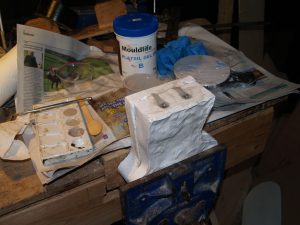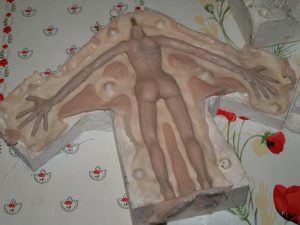Here is a sculpted puppet (in Chavant hard clay, with the armature inside) ready for casting the first half of a two-part plaster mould. It is in a bed of water clay, with some round indents to help the mould halves register accurately together. I have used some heavy gauge plastic (actually builder’s damp-proof course) to create the walls, backed up with some big chunks of water clay. It is essential to make sure all the gaps are sealed, or you could have plaster running all over the worktop and floor!
For this puppet I have also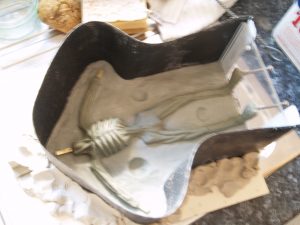
I use Crystacal R plaster, or dental stone as it is often called. There are many types of plaster, but the one to use is a hard moulding plaster with very little expansion, e.g. Hydrocal, Ultracal etc. Plaster of Paris is completely unsuitable for this sort of mould-making. Mix by adding dry plaster into a bowl of clean water, always bearing in mind that you need about three times as much plaster than water – so if you fill the bowl one-third full with water, you will end up with a completely full bowl of mixed plaster! I pour in enough to make a raised island of plaster. Ideally leave it all a couple of minutes to absorb the water before mixing to a thick creamy consistency. Brush the plaster carefully into all the crevices, to release any trapped air bubbles, and remember to put the brush in water and clean it before the plaster sets! Once the sculpt is all covered, pour in the plaster to a depth of about 20 to 25mm, then add some fibres – burlap, hessian (slightly damp) or glass fibres – before putting a final layer of plaster over the top. Tapping the table or the mould can help encourage air to rise, but it can also cause the walls to come adrift, so only do it if you have confidence in the mould not falling apart! The reason for putting a generous amount of plaster into your mould before adding fibres is so they do not reach down to the important bit – the surface against the sculpt.
Once the first half of the mould is done, remove the water-clay bed without disturbing your sculpted surface. Wash off any tiny residue. Then I make some overflow channels by placing some water-clay pieces, about 6mm thick, onto the bare plaster. These help to reduce the surface area of the mould where it mates together, enabling you to get greater pressure on the seams when clamping. You also need a few bits of clay at the edge of the mould, to create some little spaces where a screwdriver c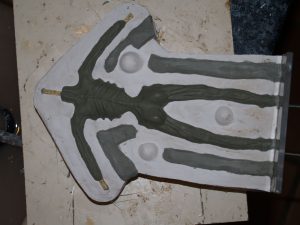
The final bit of preparation for the second half of the mould is to brush on a slip of very runny clay all over the exposed plaster. You can usually tell when you have covered all the areas because uncovered plaster is brilliant white. Don’t be tempted to use Vaseline, as it tend to leave streaks from your fingerprints or brush. A last spray of release agent, and we are done apart from building up the walls again, and sealing around the edges. I do this fairly crudely using a thin sausage of water clay pressed all around the perimeter. You can see I have also used Lego bricks for walls in one mould – the principle is the same. But Lego has small gaps between bricks, into which plaster can migrate, so I give the Lego walls a generous coating of Vaseline before use. Incidentally, Lego is perfect for small moulds for heads, arms, legs etc.
You can tell when plaster is set by a couple of signs. First, it will have gone hot, then cooled off. Second, a bit of plaster left over in the bowl will crack rather than crumble. Remember, this is a chemical reaction, a setting process, not drying. And one important tip: leave any unused plaster to set off in the bowl. By all means add water to weaken it, but DO NOT under any circumstances pour liquid plaster down your sink. It will block the plumbing and could be very expensive to put right. Just shove it to one side in a bowl and crack it out later for disposal.
I then check the fit of the armature inside the mould and prepare for pouring the silicone. My usual method is to brush a layer of silicone into the mould and over the armature (which has been covered in physio wrap and/or PTFE tape), wait until it is set, then po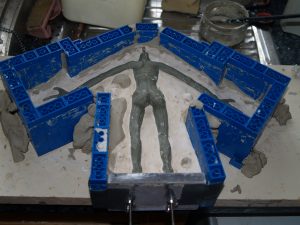
In the last but one picture I show a mould clamped in a bench vice. Portable clamps are also good. The great thing about a bench vice is that you have both hands free. You only need to clamp it enough to give thin seams – plaster does not compress, but it will crack under excessive pressure! You can see that the soles of the feet are visible, and air can escape through this route. Air travelling upwards through the arms cannot escape unless you have made some escape channels in the mould. Some people do this by laying Vaselined cocktail sticks on the first half of the mould, so there is just a tiny point where the sculpt is compromised by the channel. I find that if I have put enough silicone into the arms there is usually enough to give a complete fill.
The super professional way of filling a mould is to pour or inject silicone so it enters the mould at the bottom and drives the air out the top. Imagine a tube running
Final picture shows the finished puppet just about to be released from the mould.
